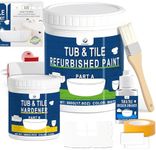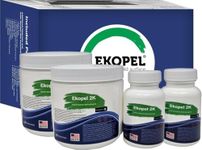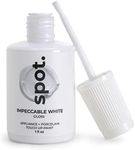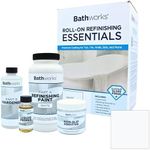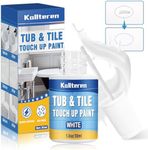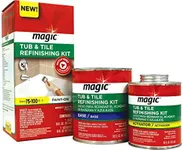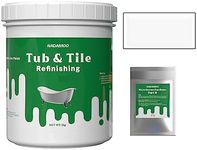Buying Guide for the Best Bathtub Paint
Choosing the right bathtub paint is important if you want to refresh or restore your bathtub without replacing it. The right paint can make your tub look new, protect it from water damage, and last for years. When shopping for bathtub paint, you should focus on a few key specifications to make sure you get a product that fits your needs and will perform well in a wet, high-use environment.Type of PaintThe type of paint refers to the chemical makeup and intended use of the product. For bathtubs, the most common types are epoxy, acrylic, and enamel paints. Epoxy paints are very durable and water-resistant, making them a popular choice for tubs that get a lot of use. Acrylic paints are easier to apply and clean up, but may not last as long in a wet environment. Enamel paints offer a glossy finish and good durability, but may require more careful surface preparation. When choosing, think about how much use your bathtub gets and how much effort you want to put into the application process.
FinishThe finish describes how shiny or matte the surface will look after the paint dries. Common finishes for bathtub paint include gloss, semi-gloss, and satin. Gloss finishes are very shiny and reflect a lot of light, making the tub look clean and new, but they can also show scratches more easily. Satin and semi-gloss finishes are less shiny and can hide imperfections better. If you want a bright, clean look, go for gloss; if you prefer something more subtle or want to hide small flaws, satin or semi-gloss may be better.
Drying and Curing TimeDrying time is how long it takes for the paint to be dry to the touch, while curing time is how long it takes for the paint to fully harden and reach its maximum durability. Some paints dry quickly but take several days to cure, while others may require a longer wait before you can use the tub. If you need to use your bathtub soon after painting, look for a product with a shorter curing time. Always follow the manufacturer's instructions to ensure the best results.
Coverage AreaCoverage area tells you how much surface a can of paint will cover, usually measured in square feet or meters. This helps you figure out how much paint you need for your project. If you have a large tub or want to apply multiple coats, you may need more paint. Measure your bathtub and compare it to the coverage listed on the paint can to make sure you buy enough.
Water and Chemical ResistanceSince bathtubs are exposed to water, soap, and cleaning chemicals, it's important that the paint you choose is resistant to these elements. Good water and chemical resistance means the paint will last longer, resist peeling or fading, and be easier to clean. Look for paints that specifically mention water and chemical resistance in their description, especially if your tub will be used frequently or cleaned often.
Application MethodBathtub paints can be applied with a brush, roller, or spray. Some paints are designed for easy brushing or rolling, while others work best with a spray gun for a smoother finish. If you are a beginner or want a simple process, look for paints that are easy to apply with basic tools. If you want a professional-looking finish and have the right equipment, spraying might be the best option.
